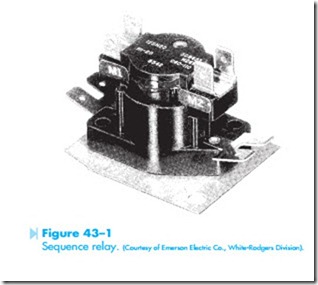A heat pump is a device that provides both heating and air conditioning within the same unit. In the cooling cycle, the outside heat exchange unit is used as the condenser and the inside heat exchanger is used as the evaporator. When the heat pump is used for heating, the reversing valve reverses the flow of refrigerant in the system and the outside heat exchanger becomes the evaporator. The inside heat exchanger becomes the condenser. Heat pumps also contain some type of back-up heating system that is used when the outside temperature is too low to make heat transfer efficient. The most common type of back-up heat is electric-resistance heat.
Heat pumps contain other control devices that are generally used only with heat-pump equipment, such as two-stage thermostats, sequence relays, and defrost timers.
TWO-STAGE THERMOSTATS
The two-stage thermostat is a thermostat that contains two separate mercury contacts. It is similar to the programmable thermostat except that the two mercury contacts cannot be set independently of each other. The mercury contacts of the two-stage thermostat are so arranged that one contact will make connection slightly ahead of the other. For example, assume the heat pump is being used in the heating mode. Now assume that the temperature drops. One of the contacts will make connection first. This contact turns on the compressor and heat is provided to the living area. If the compressor can provide enough heat to raise the temperature to the desired level, the second mercury contact does not make connection. If the compressor cannot provide the heat needed, the second mercury contact will close and turn on the electric-resistance heating elements to provide extra heat to the living area.
THE SEQUENCE TIMER
The sequence timer is an on-delay timer used to connect the heating elements to the line in stages instead of all at once. Most sequence timers contain two or three contacts and are operated by a small heating element that heats a bimetal strip. When the bimetal strip becomes hot enough, it snaps from one position to another and closes the two contacts. A pho- tograph of this type of timer is shown in Figure 43–1.
